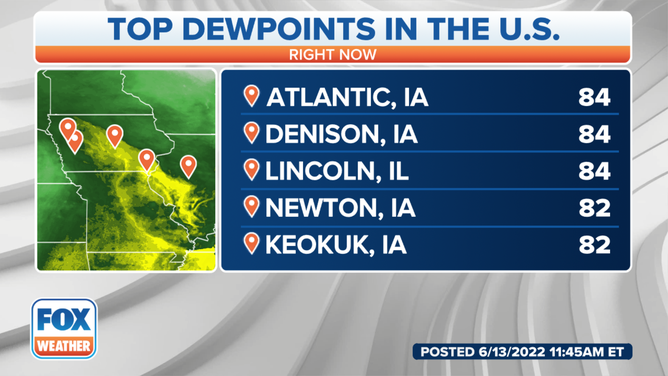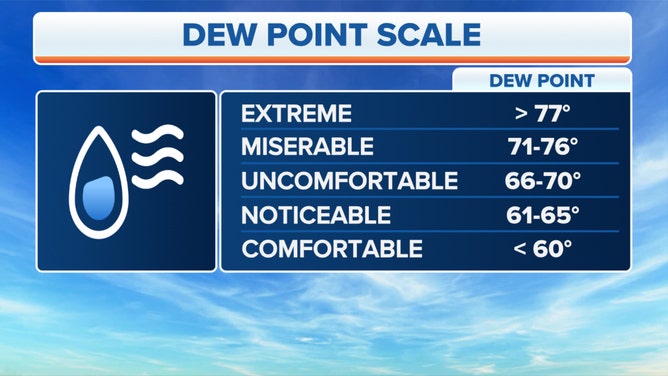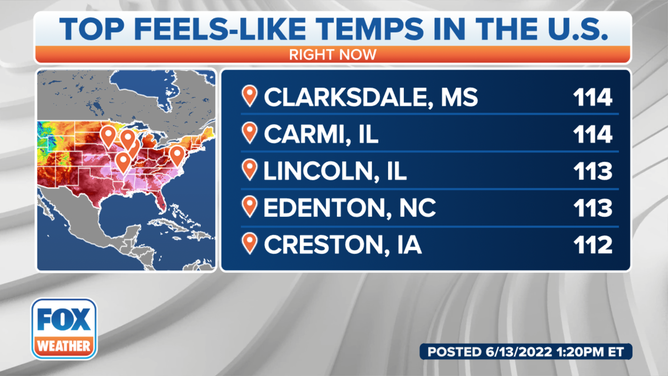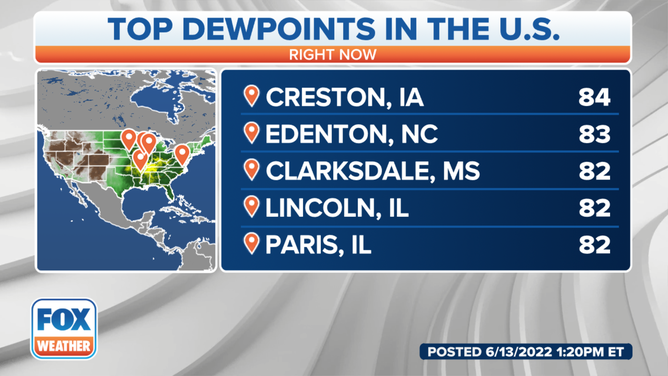Dew points reach into the 'extreme' 80s in Iowa
Dew points reached into the lower to mid-80s in some towns in Iowa and Illinois

Top U.S. dew points as of midday Monday, June 13, 2022.
CRESTON, Iowa – The weather was not only oppressively hot in parts of the Midwest and Southeast Monday, but for some areas of the Midwest, it went to another level of discomfort.
Dew points reached into the lower to mid-80s in some towns in Iowa and Illinois.
A dew point in the 70s is considered oppressive and extreme, but when they climb over 80, it's next-level yuck.

The dew point scale.
(FOX Weather)
WHY DEW POINT IS THE BEST WAY TO CLASSIFY HOW MUCH HUMIDITY IS IN THE AIR
Achievement unlocked in Iowa, where at least five towns soared past 80 degrees for a dew point. Creston hit a sweltering 84-degree dew point as did Atlantic and Denison, while Newton and Keokuk hit 82.
For Creston, the 84-degree dew point came as the air temperature was 88 degrees, meaning the air was nearly saturated and any sweat wasn't going anywhere.
While 88 degrees might seem almost manageable, with the nearly matching dew point, it felt like 112 degrees outside.
WHAT IS THE HEAT INDEX AND WHY IS IT IMPORTANT TO YOUR HEALTH?
But for Iowa and other parts of the Midwest, they're fortunate it's not later in the growing season because it could have been worse.

"Feels-like" temperatures in the U.S. on Monday, June 13, 2022.
(FOX Weather)
"Crops were planted pretty late this season due to the cold and rainy spring," says Andrew Pritchard, Senior Meteorologist at Nutrien Ag Solutions.
Corn and other plants and crops pull moisture out of the soil, and some of that moisture escapes through the leaves and enters the surrounding air. This is called transpiration.
The farms of Iowa are the No. 1 supplier of America’s corn, so there’s obviously an abundance of cornfields all throughout the Hawkeye State.
Corn (or any plant) pulls moisture out of the soil, and some of that moisture escapes through the corn's leaves and enters the surrounding air. This is called transpiration.
Just as humans sweat, or perspire, to cool down, plants are no different. The higher the air temperature, the more the plant will sweat, or transpire.
The transpired moisture will then evaporate off the plant's leaves to cool it down, just like how sweat evaporates off human skin. Evaporation is a cooling process.
HOW THE WEATHER YOU’RE ACCUSTOMED TO AFFECTS NATIONAL WEATHER SERVICE HEAT WARNINGS, ADVISORIES
Additional moisture also enters the air from lakes and other water sources in the area through evaporation. Combine all of this evaporation and transpiration, and you get evapotranspiration.
"Corn sweat" is simply a more colloquial way of referring to evapotranspiration in the vicinity of cornfields.
This process of evapotranspiration leads to increased moisture in the air near cornfields as the corn "sweats" to keep itself cool, ultimately leading to higher dew points in many areas surrounding the cornfields.
So far in mid-June, crops are still a month or so away from full size.
"They’re young plants, but growing fast – so it isn’t quite true that it’s too early for any ‘corn sweat’ impact," Pritchard said. "The impact is however quite a bit less than it will be in July and August when the corn plants are closer to 7 to 9 feet tall, rather than 7 to 9 inches tall… The corn sweat effect will be dramatically higher deeper into the summer. Bigger plants, bigger humidity impact."
What does an 80-plus-degree dew point really mean?
Dew points are used to figure out how much moisture is present in the air. In simplest terms, the dew point is the temperature to which the air must be cooled in order for it to become saturated. It provides a measure of the actual amount of water vapor in the air – so the higher the dew point, the more moisture in the air.
Once the air temperature and dew point meet, the air becomes saturated and the relative humidity reaches 100%. The dew point can never be higher than the air temperature.
Luckily, "corn sweat" isn't really a thing unless you live in the Midwest, a region covered in corn.
7 THINGS TO KNOW ABOUT SUNSCREEN
However, the current weather pattern was pulling up so much warm, moist air from the Gulf of Mexico that areas outside the corn belt were also suffering from dew points over 80 degrees, including Edenton, North Carolina (83 degrees), and Clarksdale, Mississippi (82 degrees).

Top U.S. dew points as of Monday afternoon, June 13, 2022.
(FOX Weather)
Editor's note: This story has been updated to correct that the extreme dew points in Iowa Monday were likely not the result of "corn sweat," as corn crops have not yet matured enough to be a significant contributor.